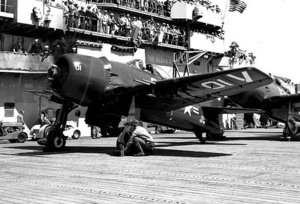F8F Bearcat
|
|
| Grumman F8F Bearcat | ||
|---|---|---|
 Grumman F8F Bearcats prepare for takeoff | ||
| Description | ||
| Role | Naval carrier fighter | |
| Crew | 1 | |
| First flight | 21 August 1944 | |
| Entered service | 21 May 1945 | |
| Manufacturer | Grumman | |
| Dimensions | ||
| Length | 28 ft 3 in | 8.6 m |
| Wingspan | 35 ft 10 in | 10.9 m |
| Height | 13 ft 10 in | 4.2 m |
| Wing area | ft² | m² |
| Weights | ||
| Empty | 7,070 lb | 3,210 kg |
| Loaded | lb | kg |
| Maximum takeoff | 12,947 lb | 5,870 kg |
| Powerplant | ||
| Engine | Pratt & Whitney R-2800-34W Double Wasp radial | |
| Power | 2,100 hp | 1,600 kW |
| Performance | ||
| Maximum speed | 421 mph | 680 km/h |
| Combat range | miles | km |
| Ferry range | 1,105 miles | 1,780 km |
| Service ceiling | 38,700 ft | 11,800 m |
| Rate of climb | 4570 ft/min | 1,390 m/min |
| Wing loading | lb/ft² | kg/m² |
| Power/Mass | hp/lb | kW/kg |
| Armament | ||
| Guns | 4 × 20 mm cannon | |
| Bombs | 2 × 1,000 lb bombs | 2 × 450 kg bombs |
| Rockets | 4 × 0.5 in (12.7 mm) rockets | |
| Other | ||
The Grumman F8F Bearcat was the company's final piston engined fighter aircraft. Designed for the interceptor fighter role, the design team's aim was to create the smallest, lightest fighter that could fit around the Pratt & Whitney Double Wasp engine (carried over from the F6F Hellcat) and the armament of four 20mm cannon. Compared to its predecessor, the Bearcat was 20% lighter, had a 30% better rate of climb, and was 50 mph (80 km/h) faster. In comparison with the Vought F4U Corsair, the Bearcat was marginally slower but was much more heavily armed, more manuverable and climbed faster. Many features of its design were inspired by a captured Focke-Wulf Fw 190 fighter that had been handed over to the Grumman facilities.
The F8F prototypes were ordered in November 1943 and first flew on 21 August, 1944, a mere nine months later. The first production aircraft was delivered in February 1945 and the first squadron was operational by 21 May, but World War II was over before the aircraft saw combat service.
Postwar, the F8F became the major Navy fighter, equipping 24 fighter squadrons. Their performance was such that they outmatched even many early jets, but that advantage soon evaporated; the Grumman F9F Panther largely replaced it in USN service.
Other nations that flew the Bearcat included the French and Thai air forces. The French aircraft saw combat service in French Indochina in a fighter-bomber role in the early 1950s.
A fairly large number of Bearcats survive; approximately eleven are airworthy, eight are restored for display and approximately a dozen are wrecks or restoration projects. Bearcats have been fairly popular in air racing, and one, the Rare Bear owned by Lyle Shelton is the holder of the record as the "fastest propeller-driven aircraft in the world" (averaged over a 3km course) at 528.33 mph (850.26 km/h), set in 1989.
| Related content | |
|---|---|
| Related development | |
| Similar aircraft | |
| Designation series | |
| Related lists |
List of military aircraft of the United States - List of fighter aircraft |
|
Lists of Aircraft | Aircraft manufacturers | Aircraft engines | Aircraft engine manufacturers Airports | Airlines | Air forces | Aircraft weapons | Missiles | Timeline of aviation |
